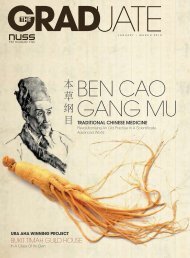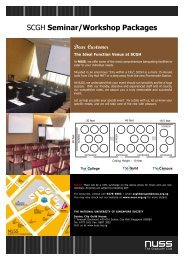The view from singapore with British High Commissioner to ... - NUSS
The view from singapore with British High Commissioner to ... - NUSS
The view from singapore with British High Commissioner to ... - NUSS
Create successful ePaper yourself
Turn your PDF publications into a flip-book with our unique Google optimized e-Paper software.
Who’s at risk? Mostly individuals<br />
who wear shoes that are tight,<br />
narrow or a size <strong>to</strong>o small, especially<br />
women. However, some people appear<br />
<strong>to</strong> face an inherited risk.<br />
How it feels: A persistent or intermittent<br />
pain around your big <strong>to</strong>e<br />
joint, which is also restricted<br />
in movement.<br />
Soothe the pain! Switch <strong>to</strong><br />
roomier, more comfortable shoes so<br />
that your <strong>to</strong>es have space <strong>to</strong> wriggle<br />
around. Consider getting off-the-shelf<br />
or cus<strong>to</strong>m-made padded shoe inserts<br />
<strong>to</strong>o – these distribute pressure evenly<br />
when you move your feet and helps<br />
provide relief.<br />
treat the problem: Your doc<strong>to</strong>r<br />
may tape your affected foot in a normal<br />
position <strong>to</strong> reduce stress on the<br />
bunion. However this does not work<br />
in the long-term. To relieve pain, you<br />
may be prescribed medications like<br />
ibuprofen or given cortisone shots.<br />
“Surgery is considered only if<br />
the bunion causes frequent pain or<br />
interferes <strong>with</strong> your activities. Surgical<br />
procedures, such as a bunionec<strong>to</strong>my,<br />
involve surgically removing<br />
the swollen tissue <strong>from</strong> around the<br />
big <strong>to</strong>e joint and straightening it by<br />
realigning the bone. Sometimes even<br />
after surgery, there may still be pain<br />
or a bunion can recur,” noted A/Prof<br />
Inderjeet.<br />
Mor<strong>to</strong>n’s neuroma<br />
What it is: A thickening of the tissue<br />
that surrounds the digital nerve leading<br />
<strong>to</strong> the <strong>to</strong>es (usually the third and<br />
fourth <strong>to</strong>es) in response <strong>to</strong> irritation,<br />
trauma or excessive pressure.<br />
Who’s at risk? Runners and women<br />
who usually wear high-heeled, narrow<br />
shoes.<br />
How it feels: A persistent pain<br />
in your foot that feels like you are<br />
standing on a marble in your shoe.<br />
In some cases, there can be a sharp,<br />
burning pain in the ball of your foot.<br />
Your <strong>to</strong>es may also sting, burn or<br />
feel numb.<br />
Soothe the pain! Change <strong>to</strong> wider<br />
and more comfortable shoes <strong>with</strong><br />
softer soles so that the bones are<br />
spread out, reducing the pressure on<br />
the nerves. Arch supports and foot<br />
pads may help <strong>to</strong> reduce pressure.<br />
treat the problem: Your doc<strong>to</strong>r<br />
may inject corticosteroids in<strong>to</strong> the<br />
affected area or recommend a minimally<br />
invasive procedure known as<br />
cryogenic neuroablation, a procedure<br />
which exposes the nerves <strong>to</strong> extremely<br />
cold temperatures <strong>to</strong> temporarily<br />
s<strong>to</strong>p the transmission of pain signals.<br />
<strong>The</strong> surgical removal of the painful<br />
nerve may be necessary.<br />
Wearing high-heeled,<br />
narrow shoes is<br />
a risk fac<strong>to</strong>r for<br />
Mor<strong>to</strong>n’s Neuroma.<br />
living<br />
“Surgery is<br />
considered only if<br />
the bunion causes<br />
frequent pain or<br />
interferes <strong>with</strong><br />
your activities.”<br />
A/Prof inderjeet Singh<br />
Senior Consultant<br />
Department of Orthopaedic Surgery<br />
Singapore General Hospital<br />
Achilles tendinitis<br />
What it is: An inflammation of the<br />
Achilles tendon (the largest tendon<br />
in your body that connects your calf<br />
muscles <strong>to</strong> your heel bone) as a result<br />
of being under <strong>to</strong>o much strain such<br />
as during strenuous, high-impact<br />
exercises like jogging.<br />
Who’s at risk? Runners and women<br />
who wear high-heeled shoes.<br />
How it feels: A feeling of soreness<br />
and stiffness at the Achilles tendon,<br />
especially after running or climbing<br />
the stairs. Your lower leg may also<br />
feel weak and stiff.<br />
Soothe the pain! Rest your feet and<br />
apply ice on the painful area. You can<br />
also relieve the pain in your tendons<br />
by getting orthotics such as heel lifts<br />
which move the heel away <strong>from</strong> the<br />
back of the shoe so no abrasive rubbing<br />
occurs.<br />
treat the problem: Your doc<strong>to</strong>r<br />
is likely <strong>to</strong> prescribe NSAIDs such<br />
as ibuprofen <strong>to</strong> help <strong>with</strong> the pain.<br />
Treatment will also normally include<br />
leg exercises such as calf stretches<br />
that strengthen the calf muscles and<br />
reduce stress on the Achilles tendon.<br />
In severe cases, surgery, such<br />
as gastrocnemius recession (the<br />
surgical lengthening of the calf) or<br />
debridement (removing part of the<br />
Achilles tendon), and repair may be<br />
recommended.<br />
<strong>The</strong> article was contributed by Singapore<br />
Health Services (SingHealth). <strong>The</strong> group<br />
consists of the Singapore General Hospital, KK<br />
Women’s and Children’s Hospital, National<br />
Cancer Centre Singapore, National Dental<br />
Centre Singapore, National Heart Centre<br />
Singapore, National Neuroscience Institute,<br />
Singapore National Eye Centre and SingHealth<br />
Polyclinics. www.singhealth.com.sg<br />
Jan-Mar 2013 THE GRADUATE 37









